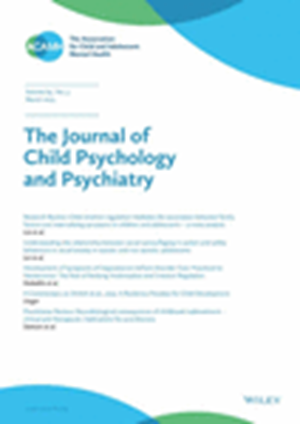青少年饮食行为:与儿童时期自闭症和多动症特征的关联以及焦虑的中介作用。
IF 7
1区 医学
Q1 PSYCHIATRY
引用次数: 0
摘要
自闭症患者和多动症患者更容易出现饮食失调,但其原因尚不清楚。我们调查了儿童时期的神经发散性(即自闭症和多动症)特征是否与青春期的情绪/克制性饮食和外部驱动性饮食行为模式有关,这些联系是否因性别而异,以及它们是否由焦虑介导。方法我们在一个具有较大人口代表性的前瞻性队列中(N = 7,572;雅芳父母与儿童纵向研究)测试了父母报告的儿童(7岁)自闭症和多动症(即多动/冲动,注意力不集中)特征与青少年(13岁)饮食行为之间的关系。我们进行了按性别分层的多组纵向分析,以了解性别是否调节神经发育特征和青少年饮食行为之间的关联。中介模型测试了观察到的关联在多大程度上受儿童中期(10岁)焦虑症状的驱动。所有分析都根据儿童性别、儿童种族、母亲教育水平和母亲出生年龄进行了调整。结果具有较高儿童自闭症特征的个体更容易报告情绪/克制(b = 0.59, 95% CI [0.29, 0.88], p <。001年,B = 0.07)和外部驱动(B = 0.17, 95%可信区间[0.05,0.28],p <。01, B = 0.06)青少年的饮食行为。此外,具有较高儿童注意力不集中特征的个体更有可能报告外部驱动的饮食行为(b = 0.10, 95% CI [0.03, 0.19], p =。02, b = 0.05)。在这些关联中没有发现性别差异。中介模型表明,焦虑对自闭症特征与情绪性/克制性饮食之间的关联具有显著的间接影响(b = 0.08, 95% ci自举[0.02,0.13])。结论儿童时期的自闭症和ADHD特征可能在青春期有一些共同的饮食行为表型(外部驱动进食),而其他特征则是自闭症特有的(情绪性/克制性进食)。我们提供的证据表明,焦虑在自闭症特征和情绪/克制饮食行为之间的关联中起着重要的作用,这表明了一个重要的潜在干预目标。本文章由计算机程序翻译,如有差异,请以英文原文为准。
Adolescent eating behaviours: associations with autistic and ADHD traits in childhood and the mediating role of anxiety.
BACKGROUND
Autistic individuals and individuals with ADHD are more likely to experience eating disorders, yet the reasons for this are not well understood. We investigated whether childhood neurodivergent (i.e. autistic and ADHD) traits are associated with patterns of emotional/restrained eating and externally driven eating behaviours in adolescence, whether these associations differed by sex and if they are mediated by anxiety.
METHODS
We tested the association between parent-reported childhood (age 7 years) autistic and ADHD (i.e. hyperactivity/impulsivity, inattention) traits and self-reported adolescent (age 13) eating behaviours in a large population-representative prospective cohort (N = 7,572; Avon Longitudinal Study of Parents and Children). We performed multi-group longitudinal analysis stratified by sex to understand whether sex moderates' associations between neurodevelopmental traits and adolescent eating behaviours. Mediation models tested the extent to which observed associations were driven by mid-childhood (age 10) anxiety symptoms. All analyses were adjusted for child sex, child ethnicity, maternal education levels and maternal age at birth.
RESULTS
Individuals who had higher childhood autistic traits were more likely to report emotional/restrained (b = 0.59, 95% CI [0.29, 0.88], p < .001, B = 0.07) and externally driven (b = 0.17, 95% CI [0.05, 0.28], p < .01, B = 0.06) eating behaviours during adolescence. Additionally, individuals with higher childhood inattention traits were more likely to report externally driven eating behaviours (b = 0.10, 95% CI [0.03, 0.19], p = .02, B = 0.05). No sex differences were identified in the associations. Mediation models suggested a significant indirect effect of anxiety for the association between autistic traits and emotional/restrained eating (b = 0.08, bootstrapped 95% CIs [0.02, 0.13]).
CONCLUSIONS
Autistic and ADHD traits in childhood may share some eating behaviour phenotypes in adolescence (externally driven eating), whereas others are specific to autism (emotional/restrained eating). We present evidence for the role of anxiety in underpinning the association between autistic traits and emotional/restrained eating behaviours, suggesting an important potential intervention target.
求助全文
通过发布文献求助,成功后即可免费获取论文全文。
去求助
来源期刊
CiteScore
13.80
自引率
5.30%
发文量
169
审稿时长
1 months
期刊介绍:
The Journal of Child Psychology and Psychiatry (JCPP) is a highly regarded international publication that focuses on the fields of child and adolescent psychology and psychiatry. It is recognized for publishing top-tier, clinically relevant research across various disciplines related to these areas. JCPP has a broad global readership and covers a diverse range of topics, including:
Epidemiology: Studies on the prevalence and distribution of mental health issues in children and adolescents.
Diagnosis: Research on the identification and classification of childhood disorders.
Treatments: Psychotherapeutic and psychopharmacological interventions for child and adolescent mental health.
Behavior and Cognition: Studies on the behavioral and cognitive aspects of childhood disorders.
Neuroscience and Neurobiology: Research on the neural and biological underpinnings of child mental health.
Genetics: Genetic factors contributing to the development of childhood disorders.
JCPP serves as a platform for integrating empirical research, clinical studies, and high-quality reviews from diverse perspectives, theoretical viewpoints, and disciplines. This interdisciplinary approach is a key feature of the journal, as it fosters a comprehensive understanding of child and adolescent mental health.
The Journal of Child Psychology and Psychiatry is published 12 times a year and is affiliated with the Association for Child and Adolescent Mental Health (ACAMH), which supports the journal's mission to advance knowledge and practice in the field of child and adolescent mental health.

 求助内容:
求助内容: 应助结果提醒方式:
应助结果提醒方式:


